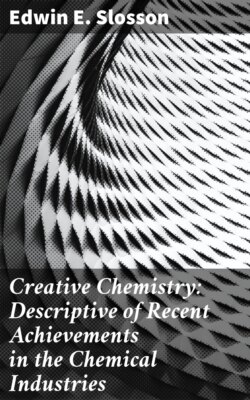Читать книгу Creative Chemistry: Descriptive of Recent Achievements in the Chemical Industries - Edwin E. Slosson - Страница 12
PRESERVER AND DESTROYER OF LIFE
ОглавлениеIn the eyes of the chemist the Great War was essentially a series of explosive reactions resulting in the liberation of nitrogen. Nothing like it has been seen in any previous wars. The first battles were fought with cellulose, mostly in the form of clubs. The next were fought with silica, mostly in the form of flint arrowheads and spear-points. Then came the metals, bronze to begin with and later iron. The nitrogenous era in warfare began when Friar Roger Bacon or Friar Schwartz—whichever it was—ground together in his mortar saltpeter, charcoal and sulfur. The Chinese, to be sure, had invented gunpowder long before, but they—poor innocents—did not know of anything worse to do with it than to make it into fire-crackers. With the introduction of "villainous saltpeter" war ceased to be the vocation of the nobleman and since the nobleman had no other vocation he began to become extinct. A bullet fired from a mile away is no respecter of persons. It is just as likely to kill a knight as a peasant, and a brave man as a coward. You cannot fence with a cannon ball nor overawe it with a plumed hat. The only thing you can do is to hide and shoot back. Now you cannot hide if you send up a column of smoke by day and a pillar of fire by night—the most conspicuous of signals—every time you shoot. So the next step was the invention of a smokeless powder. In this the oxygen necessary for the combustion is already in such close combination with its fuel, the carbon and hydrogen, that no black particles of carbon can get away unburnt. In the old-fashioned gunpowder the oxygen necessary for the combustion of the carbon and sulfur was in a separate package, in the molecule of potassium nitrate, and however finely the mixture was ground, some of the atoms, in the excitement of the explosion, failed to find their proper partners at the moment of dispersal. The new gunpowder besides being smokeless is ashless. There is no black sticky mass of potassium salts left to foul the gun barrel.
The gunpowder period of warfare was actively initiated at the battle of Cressy, in which, as a contemporary historian says, "The English guns made noise like thunder and caused much loss in men and horses." Smokeless powder as invented by Paul Vieille was adopted by the French Government in 1887. This, then, might be called the beginning of the guncotton or nitrocellulose period—or, perhaps in deference to the caveman's club, the second cellulose period of human warfare. Better, doubtless, to call it the "high explosive period," for various other nitro-compounds besides guncotton are being used.
The important thing to note is that all the explosives from gunpowder down contain nitrogen as the essential element. It is customary to call nitrogen "an inert element" because it was hard to get it into combination with other elements. It might, on the other hand, be looked upon as an active element because it acts so energetically in getting out of its compounds. We can dodge the question by saying that nitrogen is a most unreliable and unsociable element. Like Kipling's cat it walks by its wild lone.
It is not so bad as Argon the Lazy and the other celibate gases of that family, where each individual atom goes off by itself and absolutely refuses to unite even temporarily with any other atom. The nitrogen atoms will pair off with each other and stick together, but they are reluctant to associate with other elements and when they do the combination is likely to break up any moment. You all know people like that, good enough when by themselves but sure to break up any club, church or society they get into. Now, the value of nitrogen in warfare is due to the fact that all the atoms desert in a body on the field of battle. Millions of them may be lying packed in a gun cartridge, as quiet as you please, but let a little disturbance start in the neighborhood—say a grain of mercury fulminate flares up—and all the nitrogen atoms get to trembling so violently that they cannot be restrained. The shock spreads rapidly through the whole mass. The hydrogen and carbon atoms catch up the oxygen and in an instant they are off on a stampede, crowding in every direction to find an exit, and getting more heated up all the time. The only movable side is the cannon ball in front, so they all pound against that and give it such a shove that it goes ten miles before it stops. The external bombardment by the cannon ball is, therefore, preceded by an internal bombardment on the cannon ball by the molecules of the hot gases, whose speed is about as great as the speed of the projectile that they propel.
